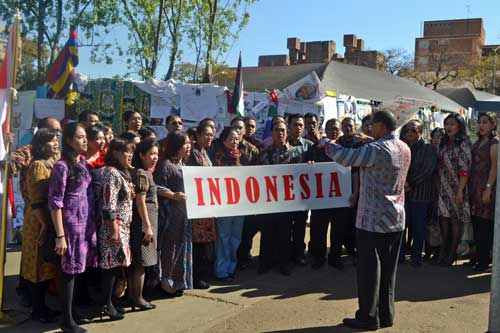19th August 2013 Daily Mirror (Sri Lanka) Impulsehttp://epaper.dailymirror.lk/epaper/viewer.aspx
"Unity in Diversity" is the motto of
Indonesia. This great nation lives truly up to the title. It is a country of
magnificent heritage with a glorious culture. Indonesia with more than 17,000
islands is one of the most vibrant and dynamic countries in Southeast Asia. Situated
centrally along the ancient trading route between the Far East and the Middle
East had resulted in many cultural practices being strongly influenced by a
multitude of religious traditions and faiths. Indonesia is a highly secular
nation that accommodates several religious communities. Islam forms the
predominant religious group in the country. The
cultural aspect of Indonesia is one that comes with a great story with its
ancient history and strong traditions. The earliest evidence of Islam in Indonesia dates back to 13th century. The
Dutch and Japanese occupation of Indonesia saw a new era of political, cultural
and religious landscape of Indonesia until the country gained Independence on 17th August 1945.
Each of the colonial rulers who ruled Indonesia left their imprint on
the current inhabitants of the country. “Indonesia Raya" is the noteworthy
national anthem of the beloved countrymen.The country’s main endowments includes its vast human
resource base, rich agricultural land and its relatively abundant water. Indonesia considers industry to be an integral
part of its plan to diversify the economy.

Indonesian Culture : Unity in Diversity
By
Srimal Fernando

The
country possesses strong development indicators and is often hailed as a model
in South East Asia .The growth achievement of the 16th largest economy in the
world is remarkable and outstanding. Today this predominantly agriculture-based economy has shifted
towards a more multi-sector economy after a robust growth. The noteworthy large
islands such as Sumatra, Java, Irian- Jaya, Indonesian Borneo, Moluccas
and Sulawesi needs little introduction to many visitors to the country.
The country enjoys historic ties with her neighboring East Asian
countries and is a member of the Association of Southeast Asian Nations
(ASEAN). Jakarta also called the Special
Capital Region of Jakarta is the country’s main center for trade,
industry, real estate, media, entertainment, tourism and has the best
educational facilities in the country. The city is renowned for its rich art
and culture as well as intellectual aura of its people. The city
provides some of the best-value tourist vacations in Indonesia. Among
its highest-esteemed attractions in the city
are the national monumental tower
with gold coated flame, the Jakarta
History Museum , the Dutch church built in 1640
and the Disney land type
Ancol Dream land . The Capital city has countless mosques having
sprawling complexes with towering minarets and is a
bustling rapidly developing place, full of traffic and crowds. Other
than capital city, Indonesia is also blessed with countless mosques, several
temples and monuments which are symbols of this great countries culture. Significant town such as Yogyakarta is famous
for its 9th century Mahayana
Buddhist monument and for its Buddha statues at Borobudur. Prambanan another
UNESCO world heritage site has the
largest Hindu temple in the country. The journey into the stunning Indonesian
island of Bali is an artist’s trip to a society. Bali is famed for steaming
volcanoes, vibrant tropical greenery, breath-taking ocean cliffs and long white
sandy beaches. It will be difficult to
over state the attraction of Indonesia for anyone who appreciates the natural
beauty of the world. Lake Toba in
the island of Sumatra, the Tanjung Puting National Park in the island of Borneo
and Torajaland a highland region of South Sulawesi are
some of the other breath-taking places visitors can explore in Indonesia. Indonesia
is a major hub for entertainment in Southeast
Asia .Various festivals held in the Indonesian islands annually attracts tourists from
all over the world and serves as a significant platform for social and
cultural gatherings. The true spirit of the country’s culture is reflected in
cuisine, literature, music, and dance and in cinema. .Indonesia is a unique
destination in Southeast Asia to visit for its
contrasts, high cultural interest and for its spectacular natural atmosphere.



